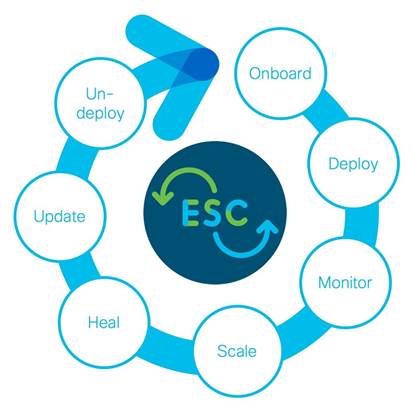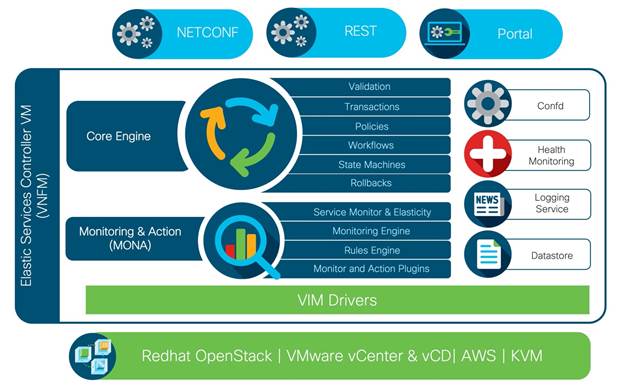Cisco Elastic Services Controller Data Sheet
Available Languages
Bias-Free Language
The documentation set for this product strives to use bias-free language. For the purposes of this documentation set, bias-free is defined as language that does not imply discrimination based on age, disability, gender, racial identity, ethnic identity, sexual orientation, socioeconomic status, and intersectionality. Exceptions may be present in the documentation due to language that is hardcoded in the user interfaces of the product software, language used based on RFP documentation, or language that is used by a referenced third-party product. Learn more about how Cisco is using Inclusive Language.
Services virtualization can improve your rate of innovation, lower your costs, and improve customer experience; however, without a capable VNF manager (VNFM), increased operational complexity can diminish the benefits you were hoping for. Cisco® Elastic Serices Controller (ESC) helps you tame this complexity with sophisticated management of your virtualized network functions throughout the service lifecycle.
Cisco ESC provides an integrated framework of tools that follow a virtual network function (VNF) throughout its entire lifecycle for both simple and complex multi-virtual-machine services. This includes a formal lifecycle stages (LCS) framework that allows you to define and vary policy based on the lifecycle stages identified in Figure 1.

Figure 1. Cisco ESC lifecycle stages
Cisco ESC lifecycle management stages
● Onboarding: includes preparing a VNF image, defining resource and networking requirements, defining monitoring metrics and thresholds, VM placement policy, lifecycle stages, and scaling rules.
● Deploy: deploys one or more VNFs, including spinning up the virtual machine (VM) and associated resources, applying affinity rules (for example, explicitly grouping or separating VNFs), loading the VNF image, applying day-0 configuration, and, finally, applying any other operation parameters or monitoring rules.
● Monitor: a set of core metrics—such as ping, memory usage, CPU load, and output bit rate—are tracked for every VNF. ESC also allows users to define additional metrics to monitor. If a defined threshold is exceeded, a predefined, built-in actions, or custom user-defined scripts can be executed.
● Scale: elastically scales instances of a VNF in response to shifting demand. The deployment configuration specifies scaling triggers and the maximum and minimum number of instances of a VNF.
● Heal: monitors the health of VMs and attempts to automatically recover from failures. Health KPIs and policies are defined as part of deployment.
● Update: updates an existing deployment—may include VMs, resources, KPIs, day-0 configuration, IP addressing, and the VNF image.
Operating environments
Cisco ESC runs as a virtual machine. It can be installed in a standalone or high availability (HA) configuration on OpenStack, VMware vCenter, KVM, or Amazon Web Services (AWS) and manages deployment of VNFs on Red Hat OpenStack and VMware vCenter Virtualized Infrastructure Managers (VIMs) as well as vCloud Director and AWS. With its standards-based software interfaces, ESC can operate as a standalone ETSI-compliant generic virtual network functions manager (gVNFM) or be deployed in concert with Cisco Network Service Orchestrator (NSO) and its NVFO core function pack as a full NVF management and orchestration (MANO) stack.
Cisco ESC architecture

Figure 2. Cisco ESC architecture
Core engine: provides the central VNF lifecycle management functions of Cisco ESC. In addition, it handles such duties as applying policy from higher layers in the orchestration stack (VNF placement, startup order, etc.), coordinating and tracking multistep and/or multi-VNF lifecycle requests, and a database-style ability to implement, roll back, and resume transactions.
Monitoring and action (MONA): provides sophisticated instrumentation and analytics of VNFs and includes a rules engine that triggers predefined or customer-defined actions based on metric thresholds and lifecycle stage.
Beyond these two key components, ESC also has components to monitor ESC for HA, a logging module, and a ConfD module for northbound NETCONF/YANG clients.
Table 1. Key Features
| Feature |
Benefit |
| Comprehensive lifecycle management of VNFs |
Full support of your services from definition to instantiation to management to tear-down |
| ETSI-compliant gVNFM |
Integrates into any ETSI-compliant MANO stack or deploys as part of the Cisco MANO solution |
| Broad support of third-party VNFs |
Ability to use and manage both Cisco and third-party VNFs |
| Intelligent handling of multi-VNF services |
Defines policy and affinity/anti-affinity rules for the deployment of complex multi-VM services |
| Advanced analytics and service monitoring/recovery |
Monitors metrics, creates rules, and define, actions around VNF and VM behavior |
| Context-sensitive, customizable workflows |
Creates workflows specific to LCS stage using built-in actions and customized scripting |
Platform support
Table 2. Supported environments
| Platform |
Supported VIM and hypervisor |
| OpenStack (Red Hat) |
Kilo, Liberty releases with Cisco ESC 2.2 Hypervisor: KVM |
| VMware |
vCenter 5.5 or 6.0 (English only) Hypervisor: vSphere 5.5 or 6.0 with VMware ESXi (English only) |
Table 3. Platform requirements
| Resource |
Supported VIM and hypervisor |
| Processor |
4 virtual CPUs (vCPUs) |
| Memory |
8 GB |
| Storage |
30 GB |
Ordering and licensing information
Cisco ESC can be ordered as a stand-alone product or as part of a VNF orchestration bundle. For details on configuration, pricing, and optional product bundles, contact your local Cisco account representative.
● Licensing is based on the number of Cisco ESC servers, the number of high availability (HA) servers, and the number of virtual CPUs being managed
● Term and perpetual licensing options are available
● Cisco ESC can be licensed as a standalone VNF manager (VNFM) or bundled with Cisco Network Services Orchestrator in an orchestration suite
Cisco ESC has a 90-day limited software warranty. For more information about the Cisco ESC warranty, see
http://www.cisco.com/en/US/docs/general/warranty/English/EU1KEN_.html.
Cisco Software Support Service (SWSS) offers complete coverage that keeps your software applications running smoothly and protects your investment with a powerful combination of services. Assistance includes software updates and upgrades, 24-hour technical support, and access to Cisco online troubleshooting tools.
What you get:
● Application software major upgrades and updates
● Global access to experts in the Cisco Technical Assistance Center (TAC)
Flexible payment solutions to help you achieve your objectives
Cisco Capital makes it easier to get the right technology to achieve your objectives, enable business transformation and help you stay competitive. We can help you reduce the total cost of ownership, conserve capital, and accelerate growth. In more than 100 countries, our flexible payment solutions can help you acquire hardware, software, services and complementary third-party equipment in easy, predictable payments. Learn more.
|